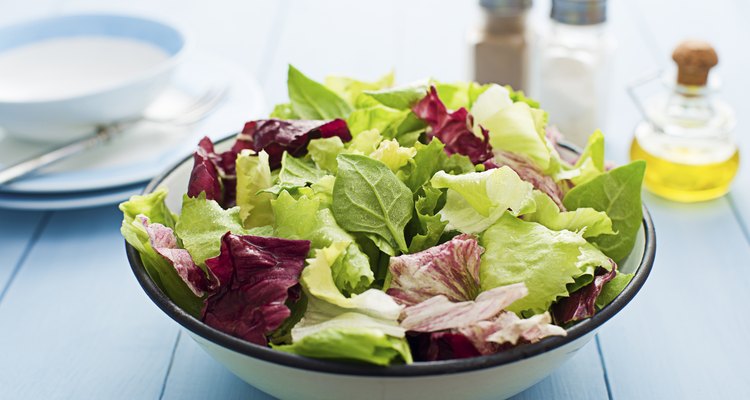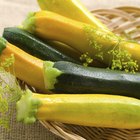
dulezidar/iStock/Getty Images
According to the U.S. Department of Agriculture's Dietary Guidelines for Americans, 2010, people need to increase their intake of fruits and vegetables and choose foods that provide more dietary fiber, calcium, potassium and vitamin D. Leafy greens fulfill this need; one serving of raw leafy greens equates to one cup, or about four leaves of lettuce. Note, however, that lettuce is not the only leafy green vegetable, nor do all leafy greens contain the same nutrition.
Minimum Intake Requirements
Dietary intake requirements vary based on an individual's gender, age, size and activity level. While health experts formerly suggested people aim for five or more servings of fruits and vegetables per day, the U.S. Department of Agriculture suggests that people look at meal proportions, rather than serving numbers, to achieve nutritional balance.
For every dining occasion, fill half your plate with fruits and vegetables. Meanwhile, the American Cancer Society still recommends eating five or more servings of fruits and vegetables each day to lower your risk of cancer. Pennsylvania State University's College of Agricultural Sciences Cooperative Extension suggests that you eat one dark leafy green or dark yellow vegetable at least every other day.
Nutrition
Naturally low in calories, sodium and cholesterol, salad greens are high in fiber and low on the glycemic index, meaning they do not cause a rapid rise or subsequent drop in blood sugar levels. Leafy greens also contain phytonutrients, which provide both color and protection for plants -- and act as antioxidants when humans ingest them. Antioxidants help lower the risk for chronic illnesses such as heart disease and cancer. More than 50 percent water, vegetables also serve as a hydrating food source.
Leafy Greens
The most common leafy green vegetable, iceberg lettuce, contains a mere 7 calories per one-cup serving. Note, however, that it also provides a lower concentration of nutrients than other leafy vegetables. In general, the darker the green, the more nutrients the leafy vegetable contains. Also, baby greens are usually more nutritious than mature varieties.
According to the Colorado State University Extension, red-leaf lettuce is particularly high in vitamin A, vitamin B-6 and beta carotene, while green-leaf lettuce provides higher amounts of vitamin K, niacin and riboflavin. For higher concentrations of vitamin C, folic acid and potassium, look to romaine lettuce, while Bibb lettuce contains higher amounts of iron. For calcium, look to the darker green leafy vegetables such as kale, mustard greens, bok choy and turnip greens.
Consumer Tips
To keep salads interesting, try varying their colors, textures -- and varieties. Some less typical leafy greens include arugula, dandelion greens, curly endive, watercress and escarole. Flavors and textures range from mild and crisp to tender and slightly bitter or tangy. Make a fresh salad of mixed baby greens or roll shredded chicken breast and diced tomatoes into a leaf of romaine to eat as a wrap.
As cool-season crops that grow quickly, lettuce and other leafy greens are easily -- and quickly -- grown and harvested at home in a variety of climates. They thrive in gardens as well as containers and usually are available in local farmers' markets. As perishables, leafy greens must be refrigerated in a plastic bag or container, washed before being eaten and consumed or discarded within a week of purchase.
Related Articles

Nutrition Information on Blueberries

List of Foods With a High Water Content

Serving Size of Steamed Asparagus

How to Juice a Daikon Radish

How Much Whole Grain Should You Eat a ...

List of High Protein Vegetables
How Many Calories Are for Breakfast, ...

How to Replace Starchy Carbs With ...

How Long Will Pineapple Juice Stay Good ...

Chef Salad Nutrition Information
How to Preserve Kohlrabi

How to Wear Skirts With a Large Stomach ...

The Calories in Garbanzo Beans

How to Make Grated Russian Beet Salad ...

How to Blanch Kale for Freezing

How to Cook Mixed Greens
Calories in a Cucumber and Avocado Roll
How to Keep and Store Watercress

Fiber in Zucchini

How to Store Brussels Sprouts
References
- Pennsylvania State University College of Agricultural Sciences Cooperative Extension; Dark Green, Leafy Vegetables; J. Lynne Brown, et al.
- Produce for Better Health Foundation, Fruits and Veggies More Matters; MyPlate and What is a Serving of Fruits and Vegetables?
- U.S. Department of Agriculture: Dietary Guidelines for Americans, 2010, Executive Summary
Resources
Writer Bio
A native Midwesterner, Kristie Bishopp has been writing professionally since 1992. She started out as a technical writer and editor for a newsletter firm, then wrote several novels published under various pen names. Bishopp holds bachelor's degrees in magazine journalism and English literature from the University of Missouri-Columbia.
Photo Credits
dulezidar/iStock/Getty Images